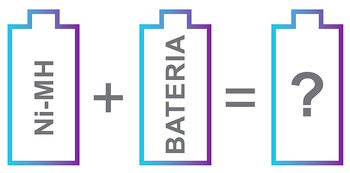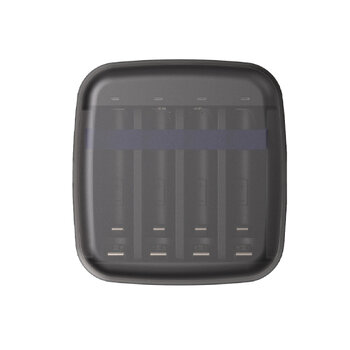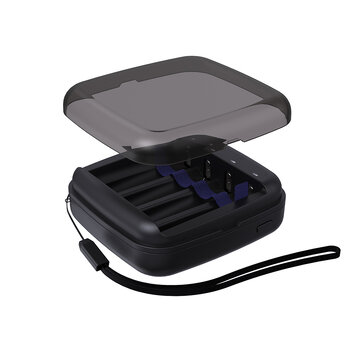- Tips
- technology
- Frequently Asked Questions
- Tests
- mAh capacity
- Rated Capacity
- everActive
- comparison
- Durability of rechargeable batteries
- Efficiency of rechargeable batteries
- battery voltage
- Accumulated energy
- Batteries vs rechargeable batteries
- LR03 AAA
- LR6 AA
- eneloop
- AG13 LR1154 LR44
- Delta V
- Charge Cycles
- internal resistance
- charge level
- CR 2032
- memory effect
- accredited test
- SR44 357
- Hearing Batteries 675
- SR626 377
- Watch Batteries
- Polarity
- Mah
- passivation
- LS 14250
- LS 14500
R6 (AA) Ni-MH 1.2V battery? Or maybe a 1.5V alkaline battery? How about both? 1.5V Li-ion batteries - a revolution in powering devices is coming...

- Mommy... Dad... My toy doesn't work!
The batteries have died.
Again.
Ehhh...
Who among us does not know such a case? Well, probably only those who don't have their own children yet. In the case of children's toys, replacing them with Ni-MH 1.2V batteries makes perfect sense (at least in most cases). Exactly, but not always...

A new alternative to alkaline and rechargeable Ni-MH batteries
You have probably encountered a case more than once when trying to replace an alkaline battery with a rechargeable battery in a given device, the result was a little different from what we expected. It all depends on how the device is constructed – we discussed the topic of potential problems with the use of Ni-MH rechargeable batteries in another post (Why do fresh Ni-MH rechargeable batteries not work in my device or work much worse than disposable batteries?)
Let's start by presenting the basic information about alkaline batteries and Ni-MH rechargeable batteries (a detailed post on the differences between alkaline batteries and Ni-MH rechargeable batteries):
- Alkaline batteries have a rated voltage of 1.5V (a fresh battery has an unloaded voltage of even more than 1.6V, but the voltage drops quickly during operation). They are mainly suitable for devices with low and possibly medium power consumption.
- Ni-Mh batteries have a rated voltage of 1.2V (in practice, 1.2V for a battery is assumed to be the average voltage of the duty cycle; the voltage of a fully charged no-load usually exceeds 1.35V). They are mainly suitable for devices with medium and high power consumption.
while Li-ion 1.5V batteries have...
"Wait... wait... That what rechargeable batteries???
We have observed the appearance in nature of such a creation as the 1.5V Li-ion battery :)
New on the market - lithium-ion batteries with a voltage of 1.5V
The main advantage of the new rechargeable batteries: The Li-ion rechargeable batteries have a constant voltage of approx. 1.5 V throughout the entire discharge period
Use? Both where alkaline batteries, Ni-MH rechargeable batteries work well, as well as where both power sources do not work.
- Cool, isn't it?
Well! But... there is no rose without thorns. They also have their drawbacks.
The most important disadvantages of 1.5V Li-ion batteries:
- In devices that signal the charge level, they will always show about 80-100% until they simply discharge, without giving any previous signals.
- They need to be charged in a dedicated charger to fully charge them. Yes, some models can be charged in other chargers designed for ordinary 3.6/3.7V Li-ion batteries, but then they will not be optimally charged to full capacity.
- Devices with very high current consumption, requiring instantaneous current at or above 2A (e.g. a high-power external flash) may refuse to work with the new type of battery. The Li-ion battery is electronically protected and can simply be switched off under very high load conditions.
So let's take a closer look at the discharge characteristics of 1.5V Li-ion batteries compared to alkaline batteries and Ni-MH batteries.


In the case of higher loads, with a discharge of 500mA, the accumulated energy given off expressed in mWh is almost 2 times higher in the case of a Li-ion and Ni-MH cell than that which can be provided by a branded 1.5V alkaline battery.
Ni-MH and Li-ion batteries maintain their declared mAh capacities in typical applications, while an alkaline battery would reach its declared maximum only at a load of about 10mA and below. The 1.5V Li-ion battery maintains by far the highest average operating voltage, regardless of the load, which in typical applications is approx. 1.40-1.50V over the entire period of use/discharge.
Other characteristics of 1.5V Li-ion batteries
The nominal voltage of the cell that is in it is 3.7V (yes, I know that I write about it that it has 1.5V).
The voltage at the output is much lower thanks to the use of a converter, which turns this battery into the most universal battery available on the market.
The problem with alkaline batteries is that in devices with high power consumption, they are very often inefficient and discharge quickly (the voltage drops very quickly) and need to be replaced frequently. Ni-MH batteries, on the other hand, are ideal for devices with high power consumption. Unfortunately, there are cases in which these rechargeable batteries perform much worse than ordinary batteries. Some devices rely quite heavily on a sufficiently high starting voltage, and this is lower than in the battery. The devices will work on them: weaker, shorter or... not at all.
A perfect example here are blood pressure monitors – they work much shorter on Ni-MH batteries than on ordinary batteries. Also devices that have LCD displays and are powered by several batteries – here, in the case of a series connection, we have a much lower total output voltage, so the data on the display may be difficult to see. We have described this topic in more detail in this post - link
This is where the 1.5V Li-ion battery comes to the rescue. It will work perfectly in any of the above cases. In addition, Li-ion batteries are much more tolerant to extreme temperatures. Another advantage is the virtually zero self-discharge rate – it will always be ready for use after charging. The only small, tiny minus may be their aforementioned current efficiency – up to 2A. Admittedly, it is not little, but there may be devices (flashes) for which it may not be a bit little... But as I said – there is no rose without a thorn ;)
1.5V Li-ion batteries and chargers for 1.5V Li-ion batteries in the hurt.com.pl store:
,
Battery charger R03 / AAA and R6 / AA Li-ion 1.5V / NiMH Xtar BC4
Professional processor charger for 1.5V Li-ion and NiMH cells in sizes AA/R6, AAA/R03.
Li-ion charging method: CC/CV
NiMH charging method: 0△V and -△V
four independent charging channels
charging current: 0.5A x 4
USB-powered Type-C - no power supply included
protection: thermal, short circuit, against reverse insertion of the battery
Author: Mariusz Walc
Copying the content of the text or its part without the consent of a representative of Baltrade sp. z o.o. is prohibited.
-
Mam od jakiegoś czasu takie akumulatorki Xtar z portami microusb do ładowania samym kabelkiem bez osobnej ładowarki - super sprawa. Natomiast po prawie 2 latach praktycznie przestałem ich używać przez wspomnianą w artykule wadę - nie ma sposobu, żeby ocenić stopień naładowania akumulatorka, a rozładowanie objawia się nagłym odcięciem prądu. Głównie potrzebuję baterii do latarek i ta wada niestety deklasuje je dla mnie całkowicie - najmniej pożądaną rzeczą jest chodzenie gdzieś po lesie z latarką i zastanawianie się w którym momencie nagle zostanę całkowicie bez światła, a czasem może być to nawet niebezpieczne. Baterie alkaliczne i akumulatorki NiMh dają pewien czas słabnącego świecenia, co pozwala przygotować się na wymianę baterii, a to jest bardzo ważne w niektórych sytuacjach. Gdyby wyszedł akumulatorek Li-ion z przetwornicą, która by np. ostatnie 5% ładunku oddawała w sposób stopniowo coraz słabszy, imitujący rozładowanie NiMh, to bym chętnie się zainteresował.
Dodatkowo mam jedną latarkę, która pobiera 1.7A, więc przekracza dopuszczalne 1.5A, więc zamiast świecić dziwnie miga i nie da się jej używać.
Wiec niestety, dla mnie ta technologia się nie sprawa póki co. -
Witam, piszecie na stronie, że akumulatorki Li-ion 1,5V trzeba ładować w dedykowanej ładowarce aby w pełni je naładować. Czy ładowarka Everactive UC-4000 nadaje się do ładowania tych akumulatorów?
-
Akumulatory Li-ion typu 1,5V mają wbudowany kontroler elektroniczny, który nie tylko zapewnia stabilne wyjście o napięciu 1,5V (pomimo, że ogniwo w środku pracuje w zakresie 3.0-4.2V), a dodatkowo zapewnia prawidłowy proces ładowania tego ogniwa.
Tak naprawdę każdy z tych akumulatorków ma wbudowaną ładowarkę i wystarczy do nich podłączyć dedykowany zasilacz (który przyjmuje formę ładowarki), zwykle o napięciu wyjściowym 5V - choć specyfika i wymogi co do sposobu ładowania mogą się różnić między różnymi producentami akumulatorków 1,5V. Aby "tradycyjna" ładowarka mogła je naładować, musiałaby mieć do tego dedykowany tryb, z podwyższonym napięciem na stykach. Na ten moment nie jest nam znana żadna ładowarka uniwersalna, która w prawidłowy sposób obsługiwałaby tego typu ogniwa. W przypadku wspomnianych akumulatorów firmy Xtar i ładowarki UC-4000 - ładowarka wykryje te akumulatory jak standardowe ogniwa Li-ion i spróbuje naładować, ładowanie jednak zakończy się nieco przedwcześnie (przy ok. 70-80% naładowania) - napięcie ładowania 4.2V będzie zwyczajnie za niskie dla kontrolera wbudowanego w te akumulatory.
-

